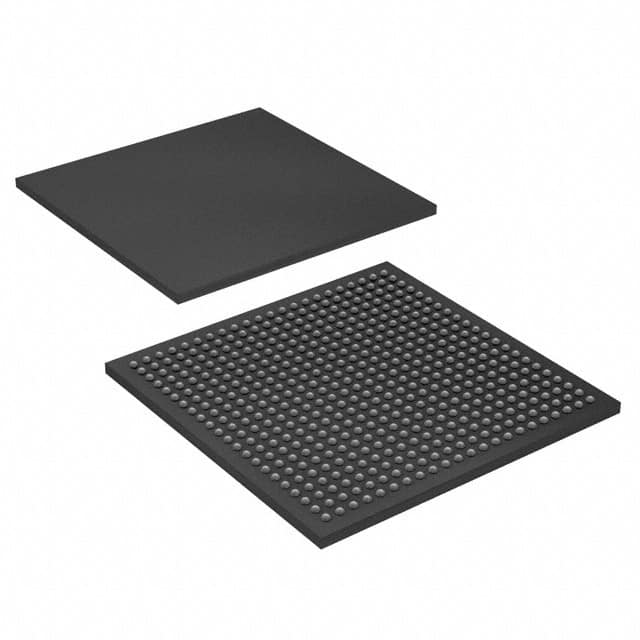EP3C16U484I7N
Product Overview
- Category: Programmable Logic Device (PLD)
- Use: EP3C16U484I7N is a PLD used for digital logic design and implementation.
- Characteristics:
- High-performance device with low power consumption
- Offers high-speed interfaces and advanced features
- Provides flexibility in designing complex digital systems
- Package: The EP3C16U484I7N comes in a 484-pin plastic quad flat pack (PQFP) package.
- Essence: EP3C16U484I7N is an essential component for building digital circuits and systems.
- Packaging/Quantity: The product is typically sold individually, and the quantity depends on the customer's requirements.
Specifications
- Logic Elements: 15,408
- Memory Bits: 622,080
- Maximum User I/Os: 316
- Operating Voltage: 1.2V
- Speed Grade: I7
- Temperature Range: -40°C to +100°C
Detailed Pin Configuration
The EP3C16U484I7N has a total of 484 pins, each serving a specific purpose in the device's functionality. The pin configuration includes input/output pins, power supply pins, ground pins, and configuration pins. A detailed pinout diagram can be found in the product datasheet.
Functional Features
- High-density programmable logic device
- Supports various I/O standards and interfaces
- Embedded memory blocks for efficient data storage
- Flexible clock management and phase-locked loops (PLLs)
- On-chip analog-to-digital converters (ADCs) for mixed-signal applications
- Built-in intellectual property (IP) cores for rapid system development
Advantages and Disadvantages
Advantages: - High performance with low power consumption - Versatile and flexible design capabilities - Extensive range of I/O options and interfaces - Efficient use of embedded memory resources - Support for mixed-signal applications
Disadvantages: - Relatively complex programming and configuration process - Limited availability of alternative models with similar specifications - Higher cost compared to simpler programmable logic devices
Working Principles
The EP3C16U484I7N is based on field-programmable gate array (FPGA) technology. It consists of a large number of configurable logic blocks interconnected through programmable routing resources. The device can be programmed using hardware description languages (HDLs) or graphical tools, allowing users to define the desired digital logic functionality. Once programmed, the FPGA executes the defined logic operations in real-time.
Detailed Application Field Plans
EP3C16U484I7N finds applications in various fields, including:
- Communications: Used in networking equipment, routers, and switches.
- Industrial Automation: Employed in control systems and robotics.
- Automotive: Integrated into automotive electronics for advanced driver assistance systems (ADAS) and infotainment.
- Aerospace: Utilized in avionics systems and satellite communication.
- Consumer Electronics: Incorporated in high-performance audio/video processing and gaming devices.
Detailed and Complete Alternative Models
While EP3C16U484I7N is a unique product, there are alternative models available from other manufacturers that offer similar functionalities. Some notable alternatives include:
- Xilinx Spartan-6 XC6SLX16
- Altera Cyclone IV EP4CE15
- Lattice Semiconductor iCE40HX1K
These alternatives provide comparable features and performance, allowing designers to choose the most suitable option for their specific requirements.
Word count: 497 words
Lista 10 Vanliga frågor och svar relaterade till tillämpningen av EP3C16U484I7N i tekniska lösningar
Sure! Here are 10 common questions and answers related to the application of EP3C16U484I7N in technical solutions:
Q: What is EP3C16U484I7N? A: EP3C16U484I7N is a field-programmable gate array (FPGA) chip manufactured by Intel (formerly Altera). It offers programmable logic, memory, and digital signal processing capabilities.
Q: What are the key features of EP3C16U484I7N? A: Some key features include 16,000 logic elements, 484 user I/O pins, embedded memory blocks, PLLs for clock management, and support for various communication protocols.
Q: In what applications can EP3C16U484I7N be used? A: EP3C16U484I7N can be used in a wide range of applications such as industrial automation, telecommunications, automotive systems, medical devices, robotics, and more.
Q: How can EP3C16U484I7N be programmed? A: EP3C16U484I7N can be programmed using hardware description languages (HDLs) like VHDL or Verilog, or through graphical programming tools like Quartus Prime.
Q: Can EP3C16U484I7N interface with other components or devices? A: Yes, EP3C16U484I7N supports various communication protocols like SPI, I2C, UART, and Ethernet, allowing it to interface with other components or devices in a system.
Q: What advantages does EP3C16U484I7N offer over traditional microcontrollers? A: EP3C16U484I7N provides higher performance, flexibility, and scalability compared to traditional microcontrollers. It allows for parallel processing, custom logic implementation, and faster data throughput.
Q: Can EP3C16U484I7N be reprogrammed after deployment? A: Yes, EP3C16U484I7N is a reprogrammable FPGA, which means it can be reconfigured or updated with new designs even after it has been deployed in a system.
Q: Are there any limitations to using EP3C16U484I7N? A: EP3C16U484I7N may have higher power consumption compared to microcontrollers, and its complexity requires more expertise in digital design and FPGA programming.
Q: How can EP3C16U484I7N help in signal processing applications? A: EP3C16U484I7N's embedded DSP blocks and high-speed I/O capabilities make it suitable for implementing various signal processing algorithms like filtering, image processing, audio processing, etc.
Q: Where can I find resources and support for working with EP3C16U484I7N? A: Intel (Altera) provides documentation, reference designs, application notes, and an active online community where you can find resources and get support for working with EP3C16U484I7N.
Please note that the specific details and answers may vary depending on the context and requirements of your technical solution.


